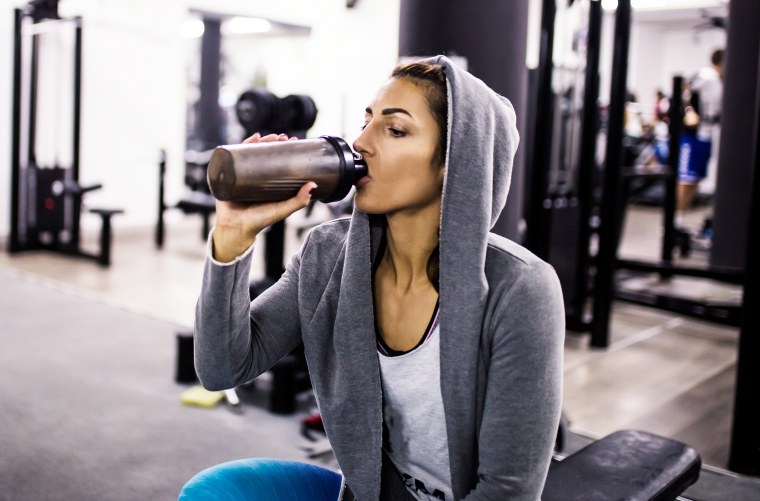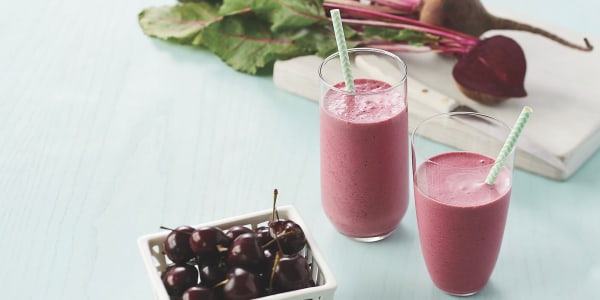You may have seen your neighbor or co-worker running around with a shaker or jar full of an opaque-looking drink. More likely than not, it’s a protein shake, and they could be drinking it for any number of reasons. If you’ve never had one, you may be wondering: Are protein shakes good for you?
Here's what to know.
How healthy are protein shakes?
Protein can help build and maintain muscle and may even help you stay slim, and protein shakes can be a useful way to boost your protein intake as part of a balanced diet.
Dozens of studies have shown that getting adequate amounts of protein can help with satiety. And some research has found that getting more than the recommended dietary allowance (RDA) can actually help with weight loss while preserving muscle mass and can even help lower triglycerides.
Most Americans are not short on protein. The average American diet provides adequate amounts of protein and certainly meets the RDA’s 10% of calories from protein. But the RDA is set to meet basic nutritional requirements as opposed to getting optimal levels. While the minimum is 10%, the guidelines actually allow for up to 35% of calories to come from protein. For an average person eating a 2,000 calorie diet, this would mean a range of 50 to 175 grams of daily protein.
Protein shakes and weight loss
For people who have struggled with regaining weight after losing it, some research shows that eating a higher protein diet may help mitigate the amount of weight regained over time, and protein shakes can help you boost your protein intake. And if you replace your meals with protein shakes, that may lower your daily calories.
However, once you start return to full meals instead of protein shakes, you're likely to gain weight back. So your best bet for using protein shakes for weight loss is too make sure you're not consuming more calories than you're burning and use them as a way to boost your protein intake if desired, per Mayo Clinic.
When should you drink protein shakes?
If you're not getting the recommended dietary allowance of protein in your diet, you may want to supplement with a protein shake, or if you are just interested in increasing your protein intake. I advise my clients to get 1 gram of protein per kilogram of body weight.
A great time to add a protein shake to your routine is pre- or post-workout.
Individuals over 65 also need to put a specific emphasis on protein intake. Research shows that older people require a higher protein intake (1.2 to 2 grams per kilograms in body weight) in order to maintain muscle mass as they age. Keeping our muscles means we’re keeping our strength and ability to do daily tasks as we age.
Some other questions to ask yourself to assess if you'd benefit from protein shakes:
- Do you usually eat a protein source (poultry, fish, meat, dairy, tofu, beans, nuts and seeds) at breakfast, lunch and dinner?
- Do you include protein in snacks?
- Do you feel that you’re struggling to feel satisfied at meals?
- Are you getting ravenous between meals?
If you answered yes to the last two questions, a protein shake might be helpful.
Keep in mind that your body can only use 30 grams of protein at a time. So, it’s smart to break up your total protein intake throughout the day, instead of loading up at dinner on an 8-ounce steak with 60 grams of protein.
Types of protein
Just 10 or so years ago, the protein shake and powder options consumers had were pretty basic. You could either go with whey protein or soy protein. Today the choices range from cricket protein to pea protein to bone broth protein and everything in between.
Most powders deliver about 15 to 20 grams of protein per serving and range from 90 calories to 200. Here’s a closer look at the options:
Whey
In terms of supporting muscles, whey is generally considered to be the gold standard. Whey protein is a by-product of the cheese-making process and provides amino acids, the building blocks of protein. Whey also blends in easily to smoothies. Research shows that it helps build muscle when combined with strength training. Whey does contain the milk sugar lactose, so it’s not for you if you follow a vegan or dairy-free diet.
Soy
This plant-based protein has been shown to be as effective as whey protein in stimulating muscle growth. Soy protein also contains isoflavones, which have been shown to protect against heart disease, osteoporosis and some cancers. Soy is one of the top nine food allergens, so that has caused many food brands to move to other plant protein sources.
Pea
For folks who need to avoid both dairy and soy, pea protein has become a great vegan alternative. Pea protein does have a slightly grassy flavor, which some people don’t love.
Brown rice
This plant-based powder is easily digested and works well in both smoothies and baked goods. Brown rice protein is low in the amino acid lysine, so it’s smart to get variety in your protein sources to cover your bases.
Hemp
If you’re trying to increase the omega-3 and 6 content in your diet, as well as your fiber intake, hemp protein may be the pick for you. Due to its fat content, you will need to refrigerate this powder.
Bone broth
Bone broth is highly nutritious and can be dried and used as a powder. People who have a hard time digesting higher fiber plant proteins may do better with easily digestible bone broth. Bone broth powder also joint supporting benefits and is paleo diet-friendly and appropriate for people who need to avoid egg protein.
Cricket
Another paleo and keto-approved protein pick is from an incredibly earth-friendly source: crickets. If you’re looking for a protein powder that uses substantially less water and land to produce, it’s a great choice. Cricket powder is also gluten, dairy and soy-free, but may not be suitable for folks who have seafood allergies.
Almond
If you love almonds, as well as simplicity, this may be your go-to powder. Made from just one ingredient, you can use almond protein powder in everything from smoothies to muffins to almond butter. In addition to providing protein, it also offers substantial amounts of naturally occurring calcium and potassium. This is a higher calorie option at 180 calories per 1/3 cup serving.
Chocho
If you haven’t heard of chocho, don’t worry — it’s one of the newest entrants in the protein powder game. Chocho is an ancient bean variety from the Andes mountains. In addition to being a sustainable protein source, chocho also has calcium, magnesium, vitamin E and is high in fiber. It’s also gluten, soy and dairy-free.
Plant blends
In addition to finding powders made from just one plant source, you’ll also find blends that combine pea with artichoke, algae or sprouted grains. If you’ve tried other plant protein powders and didn’t enjoy the flavor, you may want to consider a blend.
How to make a protein shake
The simplest way to make a protein shake is to just stir the powder into a glass of water, milk, plant milk or juice. You may want to use a shaker container for better mixing, and certainly the vanilla and chocolate-flavored protein powders are more suitable for simple shakes like this.
Smoothies are another popular way to use protein powder and can transform even the less palatable ones into delicious and satisfying drinks. You can add a scoop of protein powder to pretty much any smoothie recipe you have.
This workout recovery smoothie combines the anti-inflammatory power of cherries and pomegranate juice with nitrate-rich beets, which some studies show can increase muscle function and lower blood pressure. The addition of vanilla protein powder helps you repair and build muscle tissue.
Remember that as with most things — it’s smart to be moderate. Trying to get all of your protein from a shake is not the way to go, but adding a few servings a week may help you get the extra boost you’re looking for.


